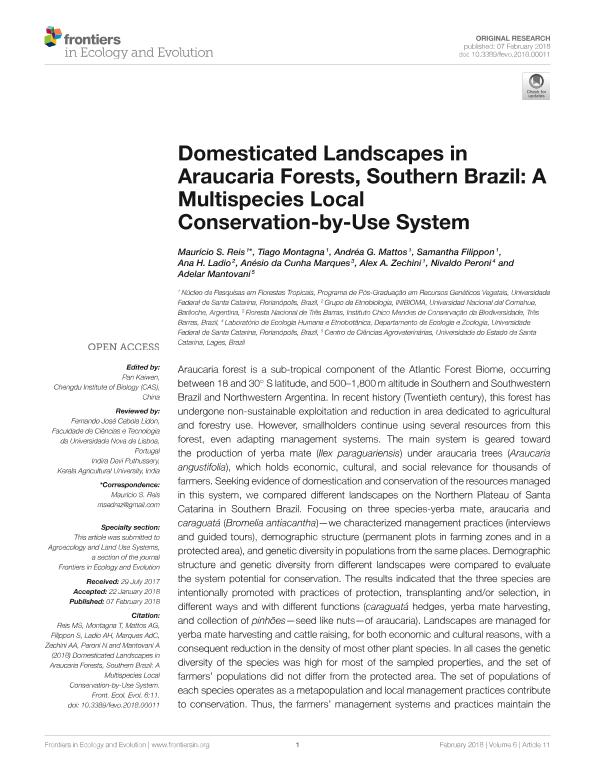Mostrar el registro sencillo del ítem
dc.contributor.author
Sedrez Dos Reis, Maurício

dc.contributor.author
Montagna, Tiago
dc.contributor.author
Mattos, Andréa G.
dc.contributor.author
Filippon, Samantha
dc.contributor.author
Ladio, Ana Haydee

dc.contributor.author
da Cunha Marques, Anésio
dc.contributor.author
Zechini, Alex A.
dc.contributor.author
Peroni, Nivaldo
dc.contributor.author
Mantovani, Adelar
dc.date.available
2020-01-22T21:46:19Z
dc.date.issued
2018-02-07
dc.identifier.citation
Sedrez Dos Reis, Maurício; Montagna, Tiago; Mattos, Andréa G.; Filippon, Samantha; Ladio, Ana Haydee; et al.; Domesticated landscapes in araucaria forests, southern Brazil: A multispecies local conservation-by-use system; Frontiers Media SA; Frontiers in Ecology and Evolution; 6; 11; 7-2-2018; 1-14
dc.identifier.issn
2296-701X
dc.identifier.uri
http://hdl.handle.net/11336/95633
dc.description.abstract
Araucaria forest is a sub-tropical component of the Atlantic Forest Biome, occurring between 18 and 30° S latitude, and 500-1,800 m altitude in Southern and Southwestern Brazil and Northwestern Argentina. In recent history (Twentieth century), this forest has undergone non-sustainable exploitation and reduction in area dedicated to agricultural and forestry use. However, smallholders continue using several resources from this forest, even adapting management systems. The main system is geared toward the production of yerba mate (Ilex paraguariensis) under araucaria trees (Araucaria angustifolia), which holds economic, cultural, and social relevance for thousands of farmers. Seeking evidence of domestication and conservation of the resources managed in this system, we compared different landscapes on the Northern Plateau of Santa Catarina in Southern Brazil. Focusing on three species-yerba mate, araucaria and caraguatá (Bromelia antiacantha)-we characterized management practices (interviews and guided tours), demographic structure (permanent plots in farming zones and in a protected area), and genetic diversity in populations from the same places. Demographic structure and genetic diversity from different landscapes were compared to evaluate the system potential for conservation. The results indicated that the three species are intentionally promoted with practices of protection, transplanting and/or selection, in different ways and with different functions (caraguatá hedges, yerba mate harvesting, and collection of pinhões-seed like nuts-of araucaria). Landscapes are managed for yerba mate harvesting and cattle raising, for both economic and cultural reasons, with a consequent reduction in the density of most other plant species. In all cases the genetic diversity of the species was high for most of the sampled properties, and the set of farmers' populations did not differ from the protected area. The set of populations of each species operates as a metapopulation and local management practices contribute to conservation. Thus, the farmers' management systems and practices maintain the landscape with productive forest fragments, favoring the conservation-by-use of these species. The system requires these management practices, which bring about changes in various species and are motivated by cultural and economic factors, in order to maintain the landscapes domesticated.
dc.format
application/pdf
dc.language.iso
eng
dc.publisher
Frontiers Media SA

dc.rights
info:eu-repo/semantics/openAccess
dc.rights.uri
https://creativecommons.org/licenses/by/2.5/ar/
dc.subject
ARAUCARIA ANGUSTIFOLIA
dc.subject
BROMELIA ANTIACANTHA
dc.subject
CULTURAL LANDSCAPES
dc.subject
ETHNOBOTANY
dc.subject
GENETIC DIVERSITY
dc.subject
ILEX PARAGUARIENSIS
dc.subject
LOCAL MANAGEMENT SYSTEM
dc.subject
NON-TIMBER FOREST PRODUCTS
dc.subject.classification
Otras Ciencias de la Tierra y relacionadas con el Medio Ambiente

dc.subject.classification
Ciencias de la Tierra y relacionadas con el Medio Ambiente

dc.subject.classification
CIENCIAS NATURALES Y EXACTAS

dc.title
Domesticated landscapes in araucaria forests, southern Brazil: A multispecies local conservation-by-use system
dc.type
info:eu-repo/semantics/article
dc.type
info:ar-repo/semantics/artículo
dc.type
info:eu-repo/semantics/publishedVersion
dc.date.updated
2019-10-10T13:47:29Z
dc.journal.volume
6
dc.journal.number
11
dc.journal.pagination
1-14
dc.journal.pais
Suiza

dc.journal.ciudad
Berna
dc.description.fil
Fil: Sedrez Dos Reis, Maurício. Universidade Federal de Santa Catarina; Brasil
dc.description.fil
Fil: Montagna, Tiago. Universidade Federal de Santa Catarina; Brasil
dc.description.fil
Fil: Mattos, Andréa G.. Universidade Federal de Santa Catarina; Brasil
dc.description.fil
Fil: Filippon, Samantha. Universidade Federal de Santa Catarina; Brasil
dc.description.fil
Fil: Ladio, Ana Haydee. Consejo Nacional de Investigaciones Científicas y Técnicas. Centro Científico Tecnológico Conicet - Patagonia Norte. Instituto de Investigaciones en Biodiversidad y Medioambiente. Universidad Nacional del Comahue. Centro Regional Universidad Bariloche. Instituto de Investigaciones en Biodiversidad y Medioambiente; Argentina
dc.description.fil
Fil: da Cunha Marques, Anésio. Instituto Chico Mendes de Conservação da Biodiversidade; Brasil
dc.description.fil
Fil: Zechini, Alex A.. Universidade Federal de Santa Catarina; Brasil
dc.description.fil
Fil: Peroni, Nivaldo. Universidade Federal de Santa Catarina; Brasil
dc.description.fil
Fil: Mantovani, Adelar. Universidade Do Estado de Santa Catarina;
dc.journal.title
Frontiers in Ecology and Evolution
dc.relation.alternativeid
info:eu-repo/semantics/altIdentifier/doi/http://dx.doi.org/10.3389/fevo.2018.00011
dc.relation.alternativeid
info:eu-repo/semantics/altIdentifier/url/https://www.frontiersin.org/articles/10.3389/fevo.2018.00011/full
Archivos asociados
